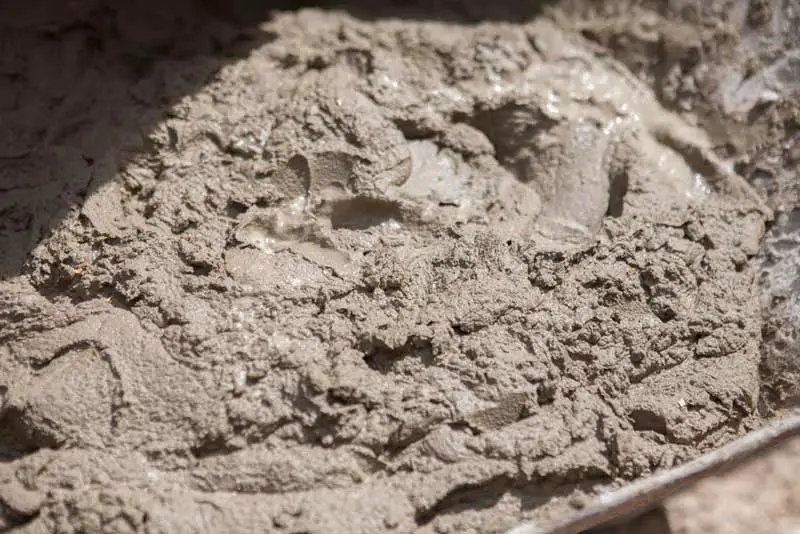
Both lime and cement are commonly used in construction today. Lime is usually used to repair old or historic buildings where cement is unsuitable. Cement is often used just about everywhere else due to its low cost, quick set times and ease of use. A common question is; Can lime be used instead of cement?
Lime is a fantastic alternative to cement. Lime building materials are highly workable and plastic. This makes them superior to use when compared to cement. In addition, lime building materials are breathable, flexible and can even self-heal. In comparison, the main advantages to cement are its quick set time, ease of use, and convenience.
Let’s take a closer look at what lime and cement are and the advantages and disadvantages of using lime instead of cement.
What is Lime?
Two main types of lime can be used as a substitute for cement—hydraulic lime and lime putty (otherwise known as fat lime). Putty-based limes set very slowly via a reaction called carbonation, whereby the mortars slowly absorb carbon dioxide in order to harden. It can take weeks to months, depending on thickness.
Alternatively, hydraulic limes are more similar to cement. They set via hydrolysis, which is a reaction with water. This causes a faster set than putty-based limes. There are three strengths of hydraulic lime. NHL 2, NHL 3.5 and NHL 5. The larger the number, the stronger the lime.
The stronger the hydraulic lime gets, the faster and harder the set. In addition, the stronger mortars will have less flexibility and breathability than the softer ones. The best type of lime for breathability and softness are putty-based mortars, plasters and renders.
As a quick side note, powdered hydrated lime (also known as builders lime) is not suitable for making mortars; it should only be used as an additive to cement mortars to help improve workability.
What is Cement?
Portland cement, like hydraulic limes, set via a reaction with water. Cements set very quickly, even when compared to hydraulic limes. In 24-48 hours, most types of cement have fully cured. This is a massive advantage as it allows for a faster build time than limes.
Cement and hydraulic limes actually share some of the same ingredients. Hydraulic lime is made using varying amounts of clay and lime. Cement is made with lime and clay as well (much more clay than hydraulic lime) with other additives depending on how strong the cement needs to be.
Generally speaking, cement is more convenient to purchase and use, as it requires little specialist knowledge when compared to lime. In addition, there are many different types of cement with varying ingredients and uses. However, cement tends to have a much larger impact on the environment than lime, which is an important factor in today’s construction projects.
Related article: Understanding the Strength of Lime Mortar vs Cement Mortar
Advantages and Disadvantages of Using Lime Instead of Cement
So, now we understand what lime and cement are and that lime can be used as an alternative to cement. Let’s take a closer look at the specific reasons why you’d want to use lime over cement.
Durability and Long-term Performance of Lime
Lime building materials have been used for thousands of years. In ancient Egypt, lime plasters were used inside temples and even some of the pyramids. Some of these very old lime plasters (over 4000 years old now) are still in excellent condition. This is a testament to the durability and long-term performance of lime building materials.

Often in today’s buildings, lime is looked at as a soft, weak and ineffective building material. This couldn’t be further from the truth. In fact, lime’s soft and flexible nature means it will often outlast any cement building. Modern cement houses are often built to last around 50-100 years, whereas there are many 200+ year-old lime-built homes across the UK today.
Lime’s soft, flexible nature allows it to shift with the building subtly. In contrast, cement is hard and brittle, and when buildings flex, it often causes the cement to crack.
Breathability and Moisture Regulation Properties of Lime
Moisture regulation has many positive effects on buildings. As you may have heard, lime is a breathable building material. This allows it to absorb and release water that would otherwise become trapped in the fabric of the building.
For example, lime constructions are much less susceptible to damp issues, water ingress, mould and moisture damage of masonry and other important materials with which the building was constructed. Again, this can help extend the lifetime of the building.
Lastly, lime’s moisture regulation can naturally help to balance internal humidity levels in a building. Lime plaster, mortar, and render can absorb excess moisture when the humidity is high. When humidity is very low, lime will dry back out. This simple process regulates the humidity. Often, this will largely contribute to the comfortability of a home built using lime.
Environmental Benefits and Sustainability of Lime
Lime is a very sustainable building material. There are vast quantities of calcium carbonate (lime) within the earth’s crust. Additionally, the manufacture of quicklime and hydraulic lime requires much less energy than cement alternatives.

As lime cures, it re-absorbs carbon dioxide (CO2) back out of the air. This is why many people refer to lime as a carbon-neutral building material. Even if it isn’t fully carbon neutral, the production and use of lime-based building materials make vastly fewer carbon emissions when compared to cement.
Another environmental benefit to using lime is that it can be recycled. Old mortars or plaster can be crushed up and added to new mortars as an aggregate. Of course, fresh lime must be added to bind the material. But this is a great example of how lime can be reused, and often, cement cannot.
Lastly, lime is usually made to be softer than the surrounding masonry of the building. This allows it to be easily repointed, as old joints can be raked out and replaced with fresh mortars without damaging the surrounding masonry. In most cases, removing cement from masonry is nearly impossible, causing the whole lot to need replacing with all fresh materials.
So, Can/Should You Use Lime Instead of Cement?
So, as we have discussed, there are many benefits to using lime instead of cement. It’s a fantastic alternative. However, there are some considerations that you should make before you decide to use lime instead.
Lime’s take much longer to set than cement mortars and plasters. As a result, they need lots of aftercare to ensure they don’t dry out too quickly or get damaged by rain and frost during the curing phase. The best times to use lime is in the spring to early summer, when it’s neither too hot nor too cold.
Related article: Why Does Lime Mortar Fail? The Common Causes and Prevention
Due to the added aftercare and extra workmanship required to use lime properly, the project will likely cost more than if it was done with cement. If you are looking for a cheap, quick job, cement is the material for you. Otherwise, you really can’t go wrong with using lime.
Personally, I would definitely use lime indeed of cement. Lime, in my opinion, is better all around. It looks beautiful, is long-lasting, environmentally friendly and requires proper workmanship to do the job properly.

